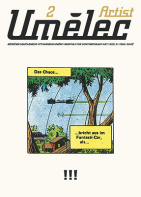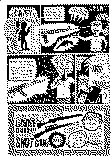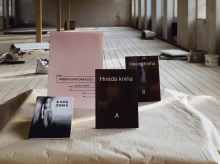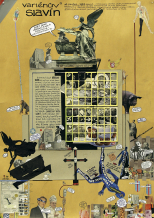| Umělec magazine 1998/2 >> I Hate the Rain | List of all editions. | ||||||||||||
|
|||||||||||||
I Hate the RainUmělec magazine 1998/201.02.1998 Michelle Falkenstein | artist | en cs |
|||||||||||||
|
"It was 5:20 on a Friday evening and the Staten Island ferry was packed with people who looked like they live in Nebraska. Not that I’ve ever been to Nebraska - I’m just guessing.
A woman told her companion that she didn’t want to sit on the boat’s lower level. “Where the fuck do you want to sit?“ he barked back. No one flinched. A guy with mutton chop sideburns wearing a red shirt, purple pants and turquoise boots sauntered by with a newspaper under his arm. A price tag still dangled from his worn-out American Tourister luggage. Staten Island, just off the coast of New York, never ceases to amaze me. When we docked 25 minutes later, hoards of people lit cigarettes as they left the boat. It was hot as hell in the ferry terminal. I raced up a ramp toward one of the exits, and as I swung open the door a blast of pungent bus exhaust smacked me in the face. It couldn’t have been any worse if I were sucking on a tailpipe. But I was there on a mission: to meet French artist Bertrand Ivanoff. Yes, even in New York City’s strangest borough there’s art worth seeing, thanks to the help of the Snug Harbor Cultural Center’s Newhouse Center of Contemporary Art. Just to the left of the ferry terminal in an abandoned warehouse a couple of miles from Snug Harbor, Ivanoff had installed a site-specific piece called “Lightwater: Sourdre”. (Sourdre, according to my Cassell’s French dictionary, means “to spring, to gush, to well.“ ) You had to go through hell to get there, but Lightwater seemed all the more an oasis after your trouble. A small laminated sign hanging from a fence on Bay Street directed me down a little hill and around a walkway next to the water. I passed an abandoned Victorian mansion with “1869“ etched in granite over the doorway. It wasn’t clear where I was headed until I came upon The Building. The building was a big, boxy, gray mass of concrete punctured by gaping windows. An East Village-type guy sitting on a folding chair out front said hi and went back to his book. There was water running down the facade and into a spreading puddle. I smelled wet metal in the cool mist. Bertrand’s installation consisted of water running through five of the building’s six floors. The place felt dangerous — scribbled graffiti on bare cement walls; wooden boards strewn about; a rickety plywood railing across the floor-to-ceiling windows that could easily be bounded. A sign at the top of the first staircase intensified my sense of foreboding: it warned viewers to use caution when moving throughout the building, to hold the hands of small children, not to enter roped-off areas and to maintain a safe distance from the windows. Mommy! I headed up the plywood stairs and enter an enormous space (80 by 70 feet, 11 foot ceilings, 36 pillars per floor) where water ran through the ceiling and splashed down on the concrete below. On the third floor, there was even more water pouring down. By the time I got to five, it was a veritable shower. That’s where I found Ivanoff. “I’m trying to capture the general atmosphere, which is pretty difficult,“ Ivanoff shouted. “With photography you need the surrounding space.“ His crew cut, dew spot and wire-rimmed glasses made him look smart, which I realized was no ruse after two minutes of conversation. When he spoke, I smelled cigarettes. Ah, French intellectuals! Ivanoff explained that 3,200 holes had been drilled through the building’s 11-inch thick floors to let the water run through. It was then gathered in a basement reservoir and pumped back up again. Ivanoff said that getting “Lightwater” produced was grueling, except for the actual installation. “My contact with the workers was great,“ he said. “It was very positive for me because they were having a physical experience of the building. They gave the physicality meaning. It was the most moving part of the project.“ The building dates from 1914, but there are minimal records of it at the Department of Buildings. Ivanoff thinks that’s because it was used to store military equipment, not the cotton or coffee that the DOB told him. “The floors can hold 250 pounds per square foot. That’s an important number,“ he said. “It was not built to store cotton.“ A plumber who worked on Lightwater told Ivanoff about an identical building in Queens, except that the other one has ramps and was used to store army tanks. “It doesn’t thrill me that it was military,“ he said. “But I didn’t want any building that could relate to love, life, food, family, fucking, anything that has memory. The fact that it was just used for storage is pretty good.“ Ivanoff, who was born and raised in Paris, started out studying medicine but quit after three years. Ten years ago, at age 31, he took up art studies. The idea for “Lightwater” came in late 1995, and Ivanoff got a grant from the French government to develop the piece. The bulk of his planning took place last year while he was artist-in-residence at the International Studio Program in Manhattan. “The planning was just the beginning of a very long process. I wanted Manhattan, but developers and owners don t want this kind of stuff,“ he said. “Even before a building would be torn down, I couldn’t get it.“ He discovered the building in Staten Island as a tourist and knew immediately that it was “perfect.“ After negotiations with the Homeowners Association of the Bay Street Landing, the space was secured. “People are scared. They think water is the ultimate risk for a building, but it’s fire,“ he said. “You can’t go to them and say, ‘I m going to invade your building with water,‘ because you’re going to get rejected. You mention that the water is going to reflect the architecture, that the sound is going to multiply the architecture, it’s a kind of multiplication and fracturing at the same time. You bring these kind of pictures.“ The neutrality of the architecture created a kind of disorientation that was, ironically, anchored by the directionality of the water. “The building has no top, back, front or bottom,“ said Ivanoff. “In painting, you have a vanishing point. With this kind of building, it’s totally reversible.“ Although this was his largest work to date, he said the size of the building was not important. What mattered to him was that he used the entire space. He showed me a portfolio of his work, which has been shown throughout France and in Brussels, London and New York. For a show in Marseille, Ivanoff used paint, water and neon lights to transform a basement. In another piece, he layered different substances in plexiglass boxes — tar, solvent, ice, varnish — to create tension between the chemicals. A cool neon tube imbedded in a block of white animal fat glowed weirdly in another work. His art feels anxious and abstract. Initially, Ivanoff was opposed to the idea of a reservoir for Lightwater; he wanted the water to run through the building only once. “The reservoir is very beautiful,“ he conceded. “But it’s like a condom, so the work is not as sexy...The original title of the piece was “I Just Want to Touch Your Skin” but people said it was too long and romantic and that‚ they wouldn’t understand. I don’t know who they‘ are.“ Suddenly, “they“ showed up. A man and woman with about half a mouth of teeth between them arrived on the fifth floor. The woman overheard us talking about Lightwater. As her partner ran through the space, screaming and howling, she asked Ivanoff, “What is the purpose of having an indoor pipe leak?“ “The purpose is how the building is going to face the water. It’s about the confrontation of solid structure and fluid structure,“ he patiently explained. “I say it’s a pipe busted,“ the woman said cheerfully. Her companion ran back to our side of the room. “Why do you want to see a broken pipe?“ she asked him. “You don’t see no purpose? Run through it! It’s a pleasure to me,“ he yelled, and took off again, hooting and flapping his arms. He reminded me of the people I saw at Christo’s wrapped Reichstag in Berlin two years ago, laughing at the sheer exuberance of the work. “These are the kind of people I love,“ Ivanoff said later. “I love reactions, even if they run out after two floors.“ We tried to see the reservoir, but it was well after 7:00 p.m. and the basement had been locked. I stuck my head through a hole in the wall, but all I could see were shadows and an umbrella. Ivanoff and I rode the ferry together back to Manhattan. “For some people, it’s a game,“ he said of “Lightwater”. “I understand it as a contemplative piece. Especially in New York, where it’s so difficult to have time to dream.“ Later, we talked about the weather, and I told him how much I love the winter. “Oh no!“ he protested. “I hate the rain.“ "
01.02.1998
Recommended articles
|
|||||||||||||
|
04.02.2020 10:17
Letošní 50. ročník Art Basel přilákal celkem 93 000 návštěvníků a sběratelů z 80 zemí světa. 290 prémiových galerií představilo umělecká díla od počátku 20. století až po současnost. Hlavní sektor přehlídky, tradičně v prvním patře výstavního prostoru, představil 232 předních galerií z celého světa nabízející umění nejvyšší kvality. Veletrh ukázal vzestupný trend prodeje prostřednictvím galerií jak soukromým sbírkám, tak i institucím. Kromě hlavního veletrhu stály za návštěvu i ty přidružené: Volta, Liste a Photo Basel, k tomu doprovodné programy a výstavy v místních institucích, které kvalitou daleko přesahují hranice města tj. Kunsthalle Basel, Kunstmuseum, Tinguely muzeum nebo Fondation Beyeler.
|






























 New book by I.M.Jirous in English at our online bookshop.
New book by I.M.Jirous in English at our online bookshop.
Comments
There are currently no comments.Add new comment